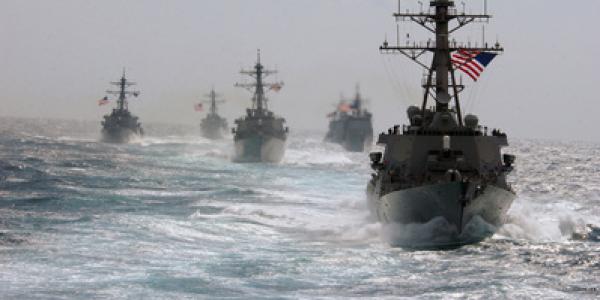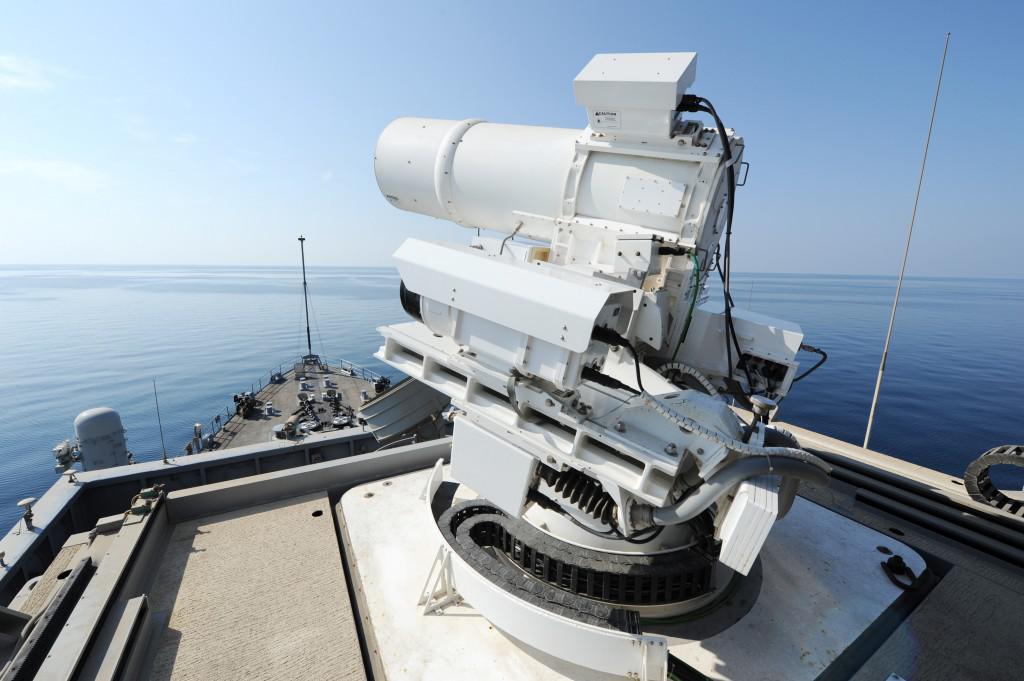Warships Set to Make Waves With Powerful Lasers
The U.S. Navy has identified laser weapons as an urgent capability need, and after many years of development, it is moving rapidly to deploy advanced laser capabilities in the near term to the fleet. The Navy is pursuing the highest-powered lasers, beginning with 60-kilowatt systems and aiming for 150-kilowatt-class systems, to be used on guided missile destroyers. Through its Program Executive Office Integrated Warfare Systems, the Navy would be the first service to have a program of record for laser energy weapons.
“This effort aligns to congressional, Defense Department and Navy goals to rapidly develop and deploy game-changing technologies,” says a public affairs spokesperson for the Naval Sea Systems Command (NAVSEA). “The Navy is pursuing multiple efforts that form the foundation of an incremental strategy for increased laser weapon capability as technology matures.”
The Navy’s two main programs include the Office of Naval Research’s (ONR’s) Solid-State Laser Technology Maturation (SSL-TM) and the High Energy Laser with Integrated Optical-dazzler and Surveillance (HELIOS).
Under the SSL-TM research program, which began in 2012, the ONR will be conducting an at-sea demonstration in the fiscal year 2019-20 time frame. The research is examining atmospheric propagation of high-energy lasers in a maritime environment; ruggedized high-energy, density-tolerant optical path components; and compact high-efficiency laser-generation technology. Meanwhile, once the first HELIOS contract is awarded, Increment 1 “will be fielded aboard a DDG 51 Flight IIA in the shortest time frame possible,” the NAVSEA spokesperson says.
These Navy programs are getting a priority boost from a Secretary of the Navy December 2016 policy, which was designed to accelerate the development, demonstration and deployment of “urgent” Navy and Marine Corps capabilities. The policy was put in place to quickly abate current threats, to offset future threats or to leverage technological advances to maintain operational and technological superiority over potential adversaries. For the Navy, these threats could include incoming ballistic and cruise missiles, unmanned aerial vehicles (UAVs), mortars and small boat swarms, among others.
Against these threats, laser weapons will provide “transformational capabilities” such as precision engagement, reduced collateral damage, deeper magazine and scalable effects, NAVSEA attests. Furthermore, the weapon systems offer “enhanced combat identification capabilities.” The cost per engagement, especially compared with expensive missiles, is also a key factor in using lasers against UAVs and other low-value targets.
“One thing that is easy for anyone to think about is what are the advantages of directed energy—the real capabilities, advantages over other kinetic weapons,” considers Lt. Gen. Henry A. (“Trey”) Obering, USAF (Ret.), executive vice president, Directed Energy, Booz Allen Hamilton. “The obvious thing is speed of light. Where do you need something from a speed of light perspective, and where do you need something that for the most part is invisible, with a low probably of intercept and very low probability of detection, that doesn’t make any noise?”
Leading all the services, the Navy “family of lasers is building on the success of the Laser Weapon System,” the NAVSEA spokesperson shares. Developed by the command and the ONR beginning in 2007, the 30-kilowatt (kW) system, known as LaWS, used off-the-shelf solid-state fiber laser technology. The system went through several development cycles—including installation aboard the guided missile destroyer USS Dewey (DDG 105) in 2012—before it achieved the functionality demonstrated on the USS Ponce, where it was deployed for three years beginning in 2014. “LaWS successfully demonstrated that laser weapons are capable of engaging UAVs, small boats and other asymmetric threats in a maritime environment,” the NAVSEA spokesperson indicates. The demonstrator “offered increased levels of precision and speed for naval warfighters at a decreased cost.”
Forward deployed for five years, the USS Ponce supported the 5th Fleet and Central Command as a retrofitted afloat special operations staging base outfitted with a joint Military Sealift Command (MSC) crew. The crew found the first operational laser weapon system to be very useful, Obering shares. Booz Allen Hamilton was an integrating contractor for LaWS.
The operation of the laser system did not go as planned—it was even better than expected, Obering says. “That’s a really important point. Originally, the Navy envisioned that they would operate it for eight hours a day. They actually operated it 24 hours a day. It proved to be one of the most effective sensors on the ship and could image at very long ranges,” he says.
Lockheed Martin’s Iain McKinnie, directed energy business development lead, adds: “It’s important to give due credit to the Navy for their work on the LaWS system on the USS Ponce. The ability to deploy a system like that on a ship and do those important demonstrations was groundbreaking. We learn so much when we put the system in the hands of the warfighters.”
Although the USS Ponce was decommissioned last October, NAVSEA will now take the LaWS system off the ship and refurbish it as a land-based test bed at the Naval Surface Warfare Center Dahlgren Division. There it will be used for risk-reduction efforts supporting future laser weapon systems, the NAVSEA spokesperson specifies.
Meanwhile, for the HELIOS solicitation, all efforts are being made to award the contract at the earliest possible opportunity, according to NAVSEA. McKinnie says, “The contract is a very bold and important step forward for the Navy.” The Defense Department released the request for proposal (RFP) last June, and companies submitted proposals two months later. As of mid-November, the contracting office was still seeking information about solicitors’ costs and past performance in the area of lasers and had extended the deadline for submissions to the end of that month. The period of performance for the intended contract is June 1, 2018, to May 31, 2028.
The Navy is looking for at least a 60-kW-class high-energy laser that has counterintelligence, surveillance and reconnaissance dazzling capability. The program will leverage “proven, mature technology” from contractors to field two test units—and additional optional production units—“as quickly and affordably as possible,” according to NAVSEA. In addition, the chosen system will provide increased self-defense and area defense, offer deep magazine capacity and significantly decrease the cost per engagement for low to midrange land, asymmetric surface and air threats.
“The Navy’s priorities for this system include technical maturity, modularity and ease of sustainment,” the NAVSEA spokesperson says. “Finally, the laser dazzler will be fielded on board a DDG 51 Flight IIA in the shortest time frame possible.”
When awarding the contracts, the highest priority will be placed on technologically mature solutions that minimize technical risk and enable an aggressive schedule for fielding capability to the fleet, the Navy indicates. Additionally, the Navy wants modularity to allow for capability upgrades as technology continues to mature. Companies have to specify operational information, such as system and weapon effects and expected damage mechanisms; type of disruption and disable results; possible engagement scenarios; engagement timelines, including duty cycles; theoretical acquisition and targeting ranges in day and night operations; and integration with external systems, sensors and weapons.
Systems not only have to operate successfully on a ship during various sea states but also have to be effective in fog, darkness and sun in a sea environment of salt spray, which may be hard on equipment and optics. They have to account for the waves and the related pitch, roll and yaw movements and the ship vibrations, along with the movement of targets.
Jim Leary, director, Boeing weapons global sales and marketing, confirms that with sea applications of laser weapons, it may be pretty rough seas for maintaining acquisition, tracking and pointing of a laser weapon. The company has successfully been able to “acquire targets at operational distances in Sea State 5 and maintain that track and destroy it,” Leary says.
The HELIOS system will be significantly more integrated with the ship than the LaWS was on the Ponce, McKinnie notes. It also will be a higher-performance system, and the addition of an optic dazzler will improve surveillance features. “LaWS, to be fair, did do surveillance as well,” but it did not include the dazzler and was only a demonstrating unit, McKinnie says.
The size of the total laser weapon system is also an issue. “Of all the platforms for laser energy weapons, people tend to think that ships are the least constraining because the ships are very large,” McKinnie continues. “That is true, but the space on the deck of a ship is really at a premium, and so while it might be more forgiving than an aircraft or a small ground vehicle, it is by no means unconstrained. If laser weapons are going to earn their place on the deck, they can’t take up too much space and can’t be too heavy.”
The Navy has acknowledged that increasing its warfighting capabilities presents power supply challenges aboard ships as well. Power-hungry weapons such as electric lasers not only require more power than other weapons but also “different” power, including pulse and stochastic power demands. Integration of laser weapon systems—along with other emerging technologies such as electronic warfare and advanced sensors—is not easy on today’s ships. The systems present maintenance, logistics, space and weight concerns, and they tend to cost more to run, given their electricity needs.
As such, the Navy is developing energy magazine prototypes and energy storage modules to boost the functionality of a ship’s electric plant. The future solutions would offer common shared energy storage and services with an integrated management system, which shifts the interface, allows flexibility for growth and saves space, weight and operating costs. Furthermore, new ships will be built with high-energy weapons in mind versus having to retrofit an advanced system into a ship such as the Ponce, commissioned in 1971.
A more efficient laser will place fewer demands on a ship, McKinnie states. The laser itself does not necessarily drive the size and weight of the laser weapon; it is driven by the power and cooling systems needed for the laser. The more efficient the laser becomes, the less heat it dissipates, which reduces the needs of a thermal cooling system and the power to drive the laser.
Another factor in laser efficiency is beam quality. With better beam quality, the laser is more useful in engaging targets. “You can have a certain amount of power coming out of a laser weapon system, but if you have poor beam quality, it just spreads widely into the atmosphere,” McKinnie warns.
Lastly, laser weapon systems will be deployed well into the coming decades, especially as the Navy plans to start building its next large surface combatant ships in fiscal year 2030. Those ships will replace the Arleigh Burke-class Flight IIA destroyers, which will begin to reach the end of their service life in 2040. As for developing naval airborne applications for lasers, NAVSEA indicates that for now, “all current efforts are focused on integrating laser weapons on naval surface combatants.”






Comments